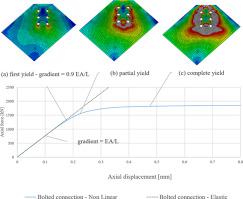当前位置:
X-MOL 学术
›
J. Constr. Steel Res.
›
论文详情
Our official English website, www.x-mol.net, welcomes your
feedback! (Note: you will need to create a separate account there.)
Buckling analysis of gusset plates with bolted connections using finite element modeling
Journal of Constructional Steel Research ( IF 4.0 ) Pub Date : 2021-01-01 , DOI: 10.1016/j.jcsr.2020.106420 D. Court-Patience , M. Garnich
Journal of Constructional Steel Research ( IF 4.0 ) Pub Date : 2021-01-01 , DOI: 10.1016/j.jcsr.2020.106420 D. Court-Patience , M. Garnich

|
Abstract Gusset plates connect lateral bracing to a building by fixing two perpendicular edges into the corners of a frame. This means that along the length of a gusset plate the cross sectional area is not uniform. For these reasons, stress distribution through a gusset plate is complex and difficult to predict. This has motivated design methods based upon approximate yield force analysis for gusset plates. The Whitmore width method (1952) is a widely adopted method used to size the yielding area of gusset plates in tension or those that do not buckle in compression. When considering buckling, international design codes prescribe equations that calculate strength curves that reduce the yielding capacity based on slenderness. However, these design code methods are based on column buckling behavior and are not specific to gusset plates. This study uses finite element modeling to study the development of yielding and buckling behavior in gusset plates with bolted connections. In total 184 variations of gusset plate geometries were modelled in Abaqus®. The simulated testing assumed an initial imperfection and applied a monotonic uniaxial load. Upon comparing results to current design methods, it was found that the Whitmore width is generally un-conservative in predicting initial yielding of gusset plates. By using the Thornton method with modifications based on FEA observations of gusset plate behavior, a new yield area and compressive strength curve suitable for gusset plates is proposed. These changes improved accuracy and safety in the design of gusset plates without adding complexity to the design process.
中文翻译:

使用有限元建模对带螺栓连接的节点板进行屈曲分析
摘要 节点板通过将两个垂直边固定到框架的角上,将横向支撑连接到建筑物。这意味着沿着角撑板的长度,横截面积是不均匀的。由于这些原因,通过角撑板的应力分布很复杂且难以预测。这激发了基于角撑板近似屈服力分析的设计方法。Whitmore 宽度法 (1952) 是一种广泛采用的方法,用于确定受拉或受压不屈曲的角撑板的屈服面积。在考虑屈曲时,国际设计规范规定了计算强度曲线的公式,这些曲线会根据细长降低屈服能力。但是,这些设计规范方法基于柱屈曲行为,并非特定于节点板。本研究使用有限元建模来研究具有螺栓连接的节点板屈服和屈曲行为的发展。在 Abaqus® 中总共模拟了 184 种角撑板几何形状的变化。模拟测试假设初始缺陷并施加单调单轴载荷。将结果与当前的设计方法进行比较后,发现 Whitmore 宽度在预测角撑板的初始屈服时通常是不保守的。通过使用基于对角撑板行为的 FEA 观察进行修改的 Thornton 方法,提出了适用于角撑板的新屈服面积和抗压强度曲线。这些变化提高了角撑板设计的准确性和安全性,而不会增加设计过程的复杂性。
更新日期:2021-01-01
中文翻译:

使用有限元建模对带螺栓连接的节点板进行屈曲分析
摘要 节点板通过将两个垂直边固定到框架的角上,将横向支撑连接到建筑物。这意味着沿着角撑板的长度,横截面积是不均匀的。由于这些原因,通过角撑板的应力分布很复杂且难以预测。这激发了基于角撑板近似屈服力分析的设计方法。Whitmore 宽度法 (1952) 是一种广泛采用的方法,用于确定受拉或受压不屈曲的角撑板的屈服面积。在考虑屈曲时,国际设计规范规定了计算强度曲线的公式,这些曲线会根据细长降低屈服能力。但是,这些设计规范方法基于柱屈曲行为,并非特定于节点板。本研究使用有限元建模来研究具有螺栓连接的节点板屈服和屈曲行为的发展。在 Abaqus® 中总共模拟了 184 种角撑板几何形状的变化。模拟测试假设初始缺陷并施加单调单轴载荷。将结果与当前的设计方法进行比较后,发现 Whitmore 宽度在预测角撑板的初始屈服时通常是不保守的。通过使用基于对角撑板行为的 FEA 观察进行修改的 Thornton 方法,提出了适用于角撑板的新屈服面积和抗压强度曲线。这些变化提高了角撑板设计的准确性和安全性,而不会增加设计过程的复杂性。











































 京公网安备 11010802027423号
京公网安备 11010802027423号